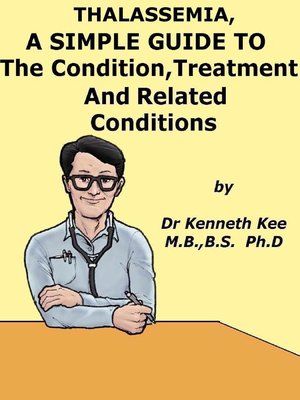
Sign up to save your library
With an OverDrive account, you can save your favorite libraries for at-a-glance information about availability. Find out more about OverDrive accounts.
Find this title in Libby, the library reading app by OverDrive.



Search for a digital library with this title
Title found at these libraries:
| Library Name | Distance |
|---|---|
| Loading... |
Thalassemia is an inherited disorder of the Red blood cells
It produces an abnormal Hemoglobin which makes the patient unwell
The patients usually inherit the disease from his parents
If both parents are affected, having thalassemia major child is 25 per cent
There are 2 types of Thalassemia:
Thalassemia major which is a serious severe form of anemia
Thalassemia minor in a person who has received only one thalassemia gene.
This person will have mild anemia and can pass his gene to his offspring.
Complications may be shock from loss of blood and hypotension
There may be liver and spleen damage from frequent blood transfusions
The result of complications is a shorter life span
Unless there is a successful marrow transplant
A person with thalassemia major will need blood transfusions throughout life.
At present a successful bone marrow transplant is the only hope to survive.
Thalassemia minor patients will have mild anemia
He or she will be well compared to the major thalassemia
-An original poem by Kenneth Kee
Interesting Tips about the Thalassemia
A Healthy Lifestyle
1. Take a well Balanced Diet
2. Standard treatments for patients with thalassemia major are blood transfusions, iron chelation, removal of the spleen, and bone marrow transplant.
a. Blood transfusion involves injection of red blood cells through a vein to restore normal levels of healthy red blood cells and hemoglobin. Transfusions are repeated every 4 months in patients with moderate or severe thalassemias and every 2 to 4 weeks in patients with beta thalassemia major.
b. Iron chelation is removal of excess iron from the body. A danger with blood transfusions is that they can cause iron overload, which may in turn cause heart disease. Because of this, patients who receive transfusions also require iron chelation therapy. One of two medicines is used for iron chelation: deferoxamine, a liquid given subcutaneously (under the skin), or deferasirox, a pill given by mouth. Patients who receive blood transfusions and iron chelation may have to take folic acid supplements to restore healthy red blood cells.
c. Splenectomy (removal of the spleen) may be needed for patients with Hemoglobin H disease whose need for transfusions is increasing.
d. Bone marrow transplant from a compatible related donor is the most effective treatment. Bone marrow transplant from a compatible brother or sister offers the best chance at a cureA bone marrow transplant is done in the hospital. Within one month, the transplanted bone marrow stem cells will start to make new, healthy blood cells.
3. Keep bones and body strong
Bone marrow produces our blood
Eat foods rich in calcium like yogurt, cheese, milk, and dark green vegetables.
Eat foods rich in Vitamin D, like eggs, fatty fish, cereal, and fortified milk.
Eat food rich in Vitamins B and C such as green vegetables and fruits
Zinc and other minerals are important to the body
4. Get enough rest and Sleep
Avoid stress and tension
5. Exercise and stay active.
It is best to do weight-bearing exercise such as walking, jogging, stair climbing, dancing, or lifting weights for 2½ hours a week.
One way to do this is to be active 30 minutes a day at least 5 days a week.
Begin slowly especially if a person has not been active.
6. Do not drink more than 2 alcohol drinks a day for a man or 1 alcohol drink a day for a woman.
Alcohol use also increases the chance of falling and breaking a bone.
Alcohol can affect the neurons and brain cells.
7. Stop or do not begin...







